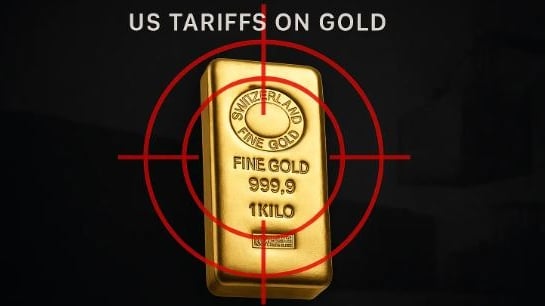Do You Know Why the Swiss Gold Industry Is in the Crosshairs After U.S. Tariffs
In 2025, the U.S. imposed a 39% tariff on Swiss gold bars, sending shockwaves through global bullion markets and threatening Switzerland’s gold refining supremacy. Learn what this move means for economies, investors, and trade relations — including perspectives from India’s bullion market.
BUSINESS & ECONOMY
Do you Know Team
8/15/20253 min read


Chances are, when you think of gold, you imagine bars, jewelry, and perhaps the price per ounce flashing across stock tickers. But few consider the critical role Switzerland plays — as the world’s premier gold refining hub. That status is now under threat after the U.S. slapped a 39% tariff on certain Swiss gold bars. This unexpected move has not only rattled markets but also pushed Switzerland to the frontlines of geopolitical trade clashes. Even the Indian bullion market isn’t immune, given Switzerland’s role in global gold flows.
Let’s unpack this rapidly shifting landscape — and why everyone from Swiss refiners to Indian investors should sit up and pay attention.
1. Switzerland: The Global Gold Refining Powerhouse
Switzerland refines over 70% of the world’s gold, transforming raw bullion into the polished, standardized bars used in everything from jewelry to central bank reserves. Four major refineries — including Valcambi — dominate the market, giving the country a near-monopoly on global fine-gold production.
2. Why Did the U.S. Tariffs Hit Swiss Gold Bars?
In early August 2025, the U.S. Customs and Border Protection reclassified 1kg and 100-ounce cast gold bars, ending their previous tariff exemption. This placed them under a sweeping 39% “reciprocal tariff” regime, part of broader trade retaliation measures. Switzerland was among the most severely impacted due to its trade surplus.
3. The Market’s Explosive Reaction
Gold futures soared to record highs above $3,500 per ounce as markets reacted to the disruption. The spread between Comex futures and London spot prices spiked dramatically, indicating severe systemic volatility.
4. Swiss Gold Bar Exports to the U.S.: A Massive Trade Flux
In just the first half of 2025, Swiss gold exports to the U.S. surged to 39 billion CHF, compared to just 1.7 billion CHF during the same period in 2024. Overall, gold accounted for 27% of Swiss exports in 2024 — making it the single largest export category.
5. Threat to Jobs and Economic Stability in Switzerland
Economic experts warn that the 39% tariff could make gold exports to the U.S. economically unviable, risking 7,500 to 15,000 jobs across refining, finance, and transport sectors.
6. Switzerland’s Pushback and Trade Negotiations
Swiss officials, led by SECO, have been negotiating with their U.S. counterparts to reduce the tariff — though President Keller-Sutter’s diplomatic mission failed to secure relief. Talks continue behind the scenes.
7. Industry Warnings: Disruption to Global Gold Flows
The Swiss Precious Metals Association cautioned that the tariff “could harm the international flow of physical gold,” especially in markets like the U.S. that rely heavily on Swiss refining.
8. Proposals to Defend Swiss Industry
Swatch CEO Nick Hayek suggested Switzerland impose a 39% export tax on gold bars to deter U.S. imports — but industry bodies warned this might backfire, damaging Switzerland’s free-trade reputation.
9. Technical Disruption: COMEX and Price Discovery
The tariff upended Comex’s gold futures trading — which assumes a smooth delivery mechanism. Now, added costs threaten to undermine the reliability of New York’s futures pricing model.
10. Indian Investors Feel the Shockwaves
India, which relies on Swiss-refined gold for bullion imports, faces price hikes on gold purchases. Indian jewelers and central banks could face difficulties hedging and maintaining reserves due to supply chain disruptions.
Frequently Asked Questions (FAQs)
Q1: What types of gold bars are affected by the U.S. tariffs?
1kg and 100-ounce Swiss cast gold bars are newly subject to the 39% tariff — previously they were exempt.
Q2: Why does this tariff matter for global markets?
Switzerland is the dominant gold refiner; disruptions there ripple into futures markets and price accuracy globally.
Q3: Did the U.S. eventually exempt gold?
President Trump stated "gold will not be tariffed," calming markets, but industry leaders emphasize the need for formal policy clarity.
Q4: How are Swiss companies adjusting?
Exports are being paused. Companies may shift refining to other hubs like Antwerp or the UAE to bypass tariffs.
Q5: What could happen next?
If tariffs remain, we could see long-term shifts in global refining centers, supply chain realignment, and increased gold provenance controls.
Conclusion
The 39% U.S. tariff on select Swiss gold bars has done more than affect a commodity — it has jeopardized Switzerland’s key refining industry and rattled the foundations of the global gold market. While short-term relief came via political statements, long-term certainty hinges on formal trade agreements. As markets search for stability, the gold that shone brightly may find itself buried under geopolitical uncertainty — with widespread consequences, from Swiss refineries to Indian investors.
#SwissGold #USTariffs #GlobalGoldMarket #GoldRefining #TradeWar #DoYouKnow #BullionTariff #PreciousMetals #IndiaGoldImports #EconomyNews
Knowledge
Empowering minds with reliable educational content daily.
Newsletter Signup
© 2025 DoYouKnow. All rights reserved.
Stay Ahead of the Trends – Join Our Newsletter
